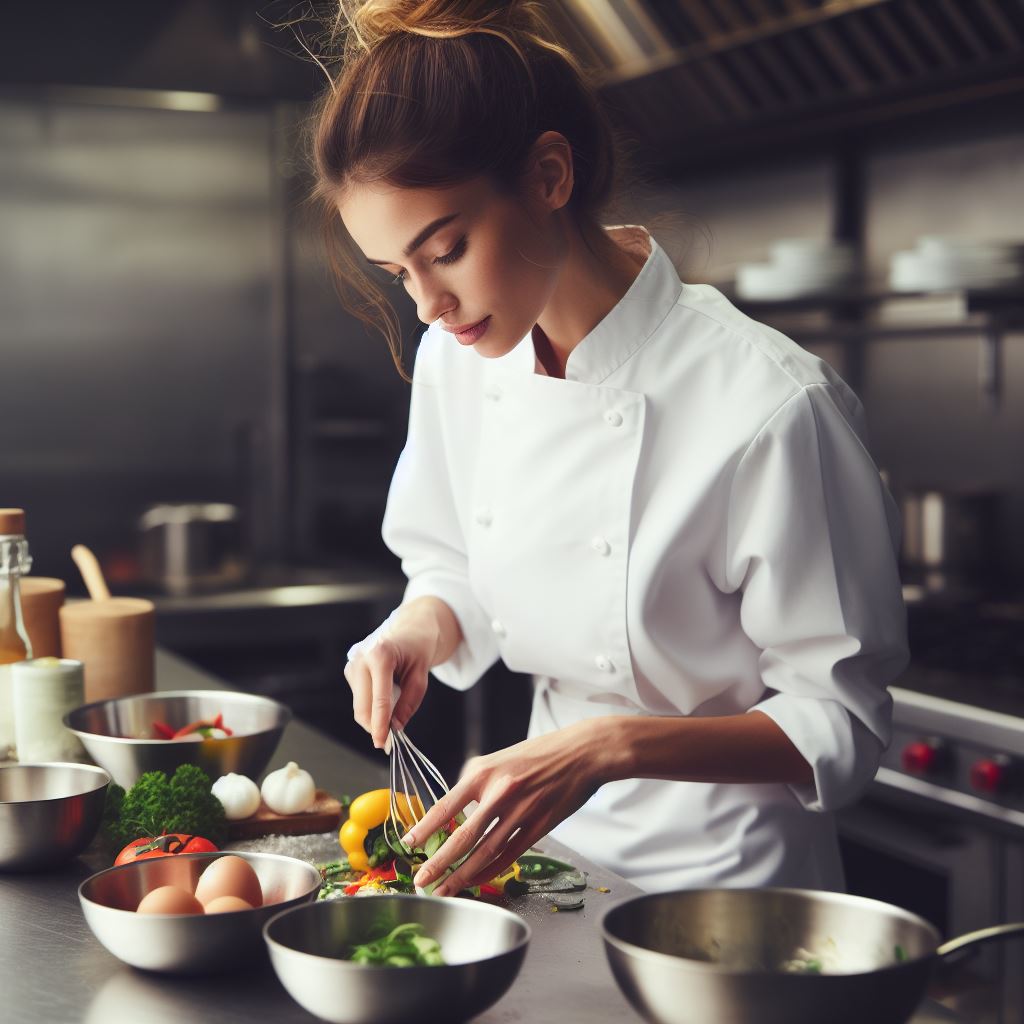Chef Attire: Understanding the Importance of Uniforms
Last Updated on November 5, 2023
Introduction
Chef attire, often regarded as a mere necessity, is a fundamental element that shapes the identity of culinary professionals.
The importance of chef uniforms transcends aesthetics. They are designed to serve several crucial purposes in a high-pressure kitchen environment.
From maintaining strict hygiene standards to ensuring safety amidst the hustle and bustle of a busy kitchen, these garments play a critical role. Moreover, they convey a sense of professionalism and authority.
In this blog post, we embark on an exploration of the multifaceted world of chef attire.
We’ll uncover the practical aspects that dictate the design of these uniforms, considering both comfort and functionality.
We’ll also delve into the cultural and historical significance that chef attire carries, exploring the evolution of traditional white coats, toques, and other elements that have become iconic in the culinary world.
Lastly, we’ll discuss how these uniforms contribute to the professional image of culinary experts and their influence on the diners’ perception of the culinary experience.
Join us on this comprehensive journey through the realm of chef attire, where each element, from the chef’s hat to the apron, plays a role far more significant than meets the eye.
Historical Significance of Chef Attire
Origins of Chef Uniforms
- Chef uniforms can be traced back to the 19th century in France.
- Marie-Antoine Carême, a famous French chef, is credited with creating the first chef uniform.
- Carême wanted his cooks to be easily recognizable, and thus, the uniform was born.
- The original uniform consisted of a white double-breasted jacket and a tall, pleated hat.
- White was chosen as the color to symbolize cleanliness and hygiene in the kitchen.
Evolution of Chef Attire over Time
- In the early 20th century, chef uniforms started incorporating functionality.
- Hat styles evolved, and the toque became a symbol of the chef’s rank and expertise.
- Chef aprons were introduced to protect clothing from spills and stains.
- The double-breasted jacket remained a staple, but with added features like removable buttons.
- Lightweight and breathable fabrics, such as cotton and linen, replaced heavier materials.
Symbolic Meaning behind Each Component of the Uniform
- The white color of the chef’s jacket signifies purity, cleanliness, and professionalism.
- The double-breasted style allows for reversible use and represents formality.
- Chef hats, or toques, have various pleats to indicate the chef’s level of experience.
- Long hats symbolize the executive chef, while shorter ones represent lower ranks.
- Modern chef pants, usually in black or checkered patterns, ensure comfort and practicality.
Functional Aspects of Chef Uniforms
Detail the practical purposes served by each element of the attire
- The Chef’s Hat: The tall hat, also known as a toque, serves to distinguish the chef’s level of experience.
- The Chef’s Jacket: The thick double-breasted jacket not only protects chefs from heat and spills but also represents professionalism and tradition.
- The Chef’s Pants: Baggy pants provide freedom of movement in the kitchen and protect against burns and cuts.
- The Chef’s Apron: An apron acts as a shield against stains, burns, and spills, keeping the chef’s clothes clean.
- The Chef’s Shoes: Non-slip and heat-resistant shoes provide chefs with stability and protect against hot spills.
The benefits of wearing appropriate chef attire in the kitchen
- Professionalism: Proper uniforms enhance the chef’s appearance and give the kitchen a sense of discipline and professionalism.
- Recognition: Chef attire distinguishes chefs from other kitchen staff, making it easier for customers to identify them.
- Brand Image: Wearing consistent and well-designed uniforms helps establish a strong brand image for the restaurant.
- Increased Confidence: When chefs dress in appropriate attire, they feel more confident and are likely to perform better.
- Protection: The right chef attire protects against heat, spills, and accidents, reducing the risk of injuries in the kitchen.
How uniforms contribute to maintaining hygiene and safety standards
- Prevent Cross-Contamination: Wearing chef uniforms helps minimize the risk of cross-contamination between different ingredients and preparation areas.
- Food Safety: Clean chef attire ensures that no dirt, hair, or bacteria get into the food during preparation, promoting food safety.
- Easy Identification of Foreign Objects: Uniforms make it easier to spot foreign objects or loose threads that may have fallen into the food.
- Personal Hygiene: Chef attire promotes personal hygiene by enforcing the habits of frequent handwashing and cleanliness.
- Compliance with Regulations: In many jurisdictions, restaurants are required by law to adhere to specific hygiene and safety standards, which include proper chef uniforms.
Chef attire serves important functional purposes in the kitchen.
Each element of the uniform, including the hat, jacket, pants, apron, and shoes, has practical benefits such as protection, freedom of movement, and maintaining cleanliness.
Wearing appropriate chef attire enhances professionalism, brand image, and customer recognition.
It also contributes to maintaining hygiene and safety standards by preventing cross-contamination, ensuring food safety, and promoting personal hygiene.
Complying with regulations regarding chef uniforms is essential for every restaurant aspiring to establish a safe and reputable kitchen environment.
Read: Gender & Diversity: Changing Dynamics in the US Kitchens
Professional Image and Branding
The role of chef attire in shaping a professional image
Chef attire plays a pivotal role in shaping a professional image, reflecting culinary expertise, discipline, and attention to detail.
The impact of uniforms on the perception of culinary establishments by customers
The impact of uniforms extends to the perception of culinary establishments by customers. A well-dressed culinary team conveys competence, cleanliness, and commitment to quality.
The importance of maintaining consistency in appearance for brand recognition
Consistency in appearance is essential for brand recognition. Uniforms are not only a statement of the chef’s identity but also a powerful tool in reinforcing the brand image.
Customers remember and identify restaurants by the attire of their chefs.
Maintaining a uniform appearance across all staff members instills trust and reliability, assuring patrons of the establishment’s commitment to quality.
In essence, chef attire is not just clothing; it’s a branding tool that influences the way diners perceive the culinary experience.
Whether it’s the traditional white coat symbolizing cleanliness or the distinctive toque blanche representing the chef’s authority, these elements collectively define the brand’s identity.
They create a sense of professionalism, instilling confidence in the culinary team’s skills and the establishment’s overall standards.
As culinary arts continue to evolve, so do the styles and variations of chef attire, allowing restaurants to express their unique identity while adhering to the time-honored traditions of the culinary world.
In this way, chef attire remains a powerful and versatile tool that goes beyond practicality, making a lasting impression and shaping the identity of culinary professionals and the establishments they represent.
Read: Famous American Chefs: Their Stories, Struggles, & Successes

Team Unity and Pride
A sense of unity within a culinary team is crucial for its success. Chef uniforms play a significant role in fostering this sense of unity.
Chef Uniforms Fostering Unity
When all members of a culinary team wear the same attire, it creates a visual representation of unity. The matching uniforms indicate that they belong to the same team and work towards a common goal.
Uniforms eliminate the hierarchy based on appearance and create a level playing field for all team members. Whether a chef is an executive or a line cook, they all wear the same uniform, reinforcing the idea of equality.
Moreover, when the culinary team wears uniforms, it becomes easier to identify who is a part of the team. This fosters a sense of camaraderie among team members and helps in building trust and collaboration.
Psychological Effects of Wearing Uniforms
Wearing chef uniforms has significant psychological effects on the chefs themselves. Firstly, the act of wearing a uniform creates a professional mindset.
When donning the chef attire, chefs subconsciously switch into their professional mode, focusing on their culinary skills and responsibilities.
Research has shown that clothing significantly impacts an individual’s self-perception and behavior. Wearing a chef uniform boosts self-confidence and instills a sense of professionalism.
Chefs feel more competent and capable when dressed in their attire, leading to enhanced performance in the kitchen.
Wearing uniforms also helps in creating a sense of discipline and order. The uniform signifies that the individual is part of a professional environment and must adhere to certain standards.
This promotes consistency in both behavior and performance, essential elements in a culinary team.
Professional Pride and Chef Attire
Being a chef is a matter of pride, and wearing the chef attire reinforces this sense of professional pride.
The uniform acts as a symbol of accomplishment and signifies the years of hard work and dedication a chef has put into honing their skills.
Chef uniforms are often associated with a rich culinary heritage and tradition.
By wearing the attire, chefs connect themselves to a long lineage of culinary excellence, carrying forward the reputation and legacy of their profession.
The chef attire also represents professionalism and expertise to customers. When diners see chefs in their crisp white coats and hats, they implicitly trust that they are in capable hands.
This trust helps in creating a positive image of the culinary team and the establishment as a whole.
Additionally, the pride associated with wearing chef attire is contagious. When chefs feel proud of their uniforms, it reflects in their work and attitude.
They take more ownership of their responsibilities, which ultimately leads to a more productive and successful culinary team.
Chef uniforms play a vital role in fostering team unity and pride. They create a visual representation of unity, have psychological effects on the chefs themselves, and instill a sense of professional pride.
By wearing the chef attire, culinary teams can work cohesively towards their goals and create a positive image of their profession.
Read: The Future of Cheffing: Technology’s Role in US Kitchens
Fashion and Style in Chef Attire
Highlight the current trends in chef attire design
- Chef jackets with bold patterns and unique prints are gaining popularity.
- Slimmer-fit pants with tapered legs are becoming more common.
- Short sleeve chef coats are being embraced in hotter climates.
- Embroidery and personalized monograms are being used to add a touch of style.
- Colorful chef hats and caps are being used to express individuality.
The importance of incorporating style while maintaining functional aspects
In today’s culinary industry, chef attire not only serves a functional purpose but also represents a chef’s individuality and brand.
Incorporating style in their uniforms helps chefs stand out and enhances their professional image.
While style is important, functionality should never be compromised. Chefs need attire that allows for easy movement, comfort, and protection in a fast-paced kitchen environment.
A balance between style and functionality is crucial.
Provide examples of creative and unique approaches to chef attire
- Chefs wearing leather aprons to add a touch of sophistication to their outfits.
- Utilizing eco-friendly fabrics made from sustainable materials for a greener approach.
- Incorporating chef jackets with hidden pockets to carry essential tools and personal items.
- Adding removable sleeves to chef coats for versatility in different kitchen environments.
- Experimenting with unconventional colors and patterns to break away from traditional white uniforms.
These examples showcase how chefs are pushing the boundaries of traditional attire and embracing creativity in their wardrobe choices.
Read: The Michelin Star: Its Impact on a Chef’s Career in the USA
Conclusion
Chef attire is not just a matter of clothing; it embodies professionalism, safety, and branding in the culinary world.
As we conclude, it’s crucial to reinforce that chef attire is far more than a set of garments. It’s a powerful symbol of culinary discipline and excellence.
It ensures safety, maintains cleanliness, and conveys a sense of professionalism in the kitchen.
Moreover, it serves as a branding tool, playing a significant role in shaping the identity and reputation of culinary establishments.
It communicates to customers that the culinary team takes their craft seriously, values cleanliness, and is committed to delivering a high-quality dining experience.
Our parting words are an encouragement to chefs—value and understand the significance of your uniforms.
These garments are not just a dress code; they are a reflection of your dedication to the culinary arts.
By appreciating their role in maintaining professionalism, ensuring safety, and building your brand, you can harness the full potential of chef attire to enhance your culinary journey and legacy.
Embrace the tradition, practicality, and symbolism of your uniform, and let it inspire you to excel in the culinary world.


